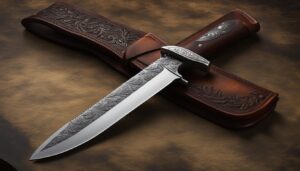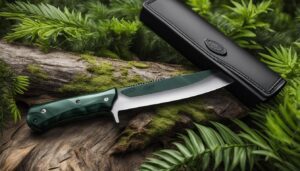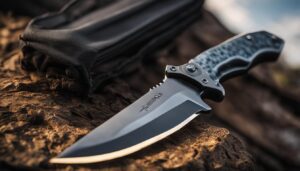Choosing the perfect hunting knife is essential for any outdoorsman or survivalist. It’s about finding a knife that fits your hand comfortably, meets your specific needs, and is made of quality materials that will last. This guide aims to empower you with the knowledge and strategies necessary to find the perfectly balanced hunting knife for you.
Key Takeaways:
- When choosing a hunting knife, prioritize comfort and functionality.
- Consider the different types of hunting knives and their specific uses.
- Set clear criteria based on size, purpose, and budget.
- Explore advanced features and technologies that enhance a hunting knife’s performance.
- Maintain and care for your hunting knife regularly to prolong its lifespan.
Understanding Hunting Knife Basics
When it comes to choosing the perfect hunting knife, it’s essential to have a good understanding of the basics. There are several types of hunting knives available, each with its own unique features and advantages. Let’s explore some of the most common types:
Fixed-Blade Knives:
Fixed-blade knives are known for their durability and strength. They have a solid, non-folding blade that provides stability and reliability during hunting tasks. These knives are typically more robust and can handle heavy-duty tasks such as field dressing game or chopping wood for campfire.
Folding Knives:
Folding knives offer convenience and versatility. They have a hinged blade that can be folded into the handle, making them compact and easy to carry. Folding knives are great for everyday carry and perform well in tasks that require precision and portability.
Specialty Knives:
Specialty knives are designed for specific hunting tasks. These knives have unique blade shapes and features tailored to meet the demands of particular hunting situations. Some examples include gut hook knives for field dressing and caping knives for delicate skinning work.
In addition to considering the type of hunting knife, it’s important to understand the anatomy of the knife. Blade shapes, materials, handles, tang, grind, and edge retention all play a role in the knife’s performance and suitability for different tasks.
Knowing the basics of hunting knives will help you make an informed decision when selecting the perfect knife for your needs. Whether you prefer a fixed-blade, folding, or specialty knife, understanding the different types and features will ensure you choose a knife that will serve you well in the field.
| Type of Hunting Knife | Features | Advantages |
|---|---|---|
| Fixed-Blade Knives | Durable, strong, non-folding blade | Stability, reliability, suitable for heavy-duty tasks |
| Folding Knives | Hinged blade that can be folded into the handle | Convenience, versatility, easy to carry |
| Specialty Knives | Designed for specific hunting tasks | Unique blade shapes and features tailored for specific needs |
Setting Your Criteria
When looking for the perfect hunting knife, it’s important to set clear criteria based on your needs and preferences. By considering factors such as size, purpose, budget, craftsmanship, and custom versus factory-made knives, you can narrow down your options and find the ideal blade for your hunting adventures.
Determining Needs
Start by determining your specific needs when it comes to a hunting knife. Think about the type of game you typically hunt and the tasks you need the knife to perform. Whether you need a versatile all-purpose knife or a specialized blade for field dressing, understanding your needs will help you choose a knife that can handle your hunting requirements.
Size and Purpose
The size and purpose of the knife are crucial considerations when setting your criteria. A larger knife with a longer blade may be suitable for heavy-duty tasks like field dressing or chopping, while a smaller knife with a shorter blade can provide greater precision for skinning or detailed work. Determine the size and purpose that aligns with your hunting style and preferences.
Budget
Your budget is another important criterion to consider. Hunting knives come in a wide range of prices, and it’s essential to determine how much you’re willing to invest. Keep in mind that higher-priced knives may offer superior craftsmanship and materials, but there are also quality options available at lower price points. Set a budget that suits your financial situation without compromising on quality.
Craftsmanship and Custom vs Factory-made
The craftsmanship of a hunting knife can significantly impact its performance and durability. Consider the reputation and expertise of the knife manufacturer or brand. Additionally, you have the option to choose between custom knives, which can be tailored to your specifications and preferences, and factory-made knives, which are often more affordable and readily available.
By setting your criteria based on determining your needs, size, purpose, budget, craftsmanship, and the choice between custom versus factory-made knives, you’ll be well-equipped to find the perfect hunting knife that meets your individual requirements.
Advanced Features and Technologies in Hunting Knives
When it comes to hunting knives, advanced features and technologies can significantly enhance their functionality and user experience. From blade coatings to ergonomic handle designs and innovative sheath designs, these advancements offer hunters a range of benefits. In this section, we will explore the different advanced features and technologies that you should consider when choosing a hunting knife.
Blade Coatings
Blade coatings are a popular feature in modern hunting knives. These coatings not only enhance the aesthetics of the knife but also improve its performance. For example, ceramic coatings provide excellent corrosion resistance, while DLC (Diamond-Like Carbon) coatings offer increased hardness and durability. Coatings can also reduce friction and minimize glare, making the knife more effective in various hunting conditions.
Ergonomic Handle Designs
The handle of a hunting knife plays a crucial role in comfort and grip. Advanced ergonomic designs take into consideration the natural contours of the hand, allowing for a secure and comfortable grip. Features such as finger grooves, textured surfaces, and ergonomic shapes ensure that the knife remains stable during use, reducing the risk of accidents and fatigue.
Innovative Sheath Designs
Sheaths are an essential component of hunting knives, providing protection and easy access. Advanced sheath designs offer improved functionality and safety. Some sheaths feature quick-release mechanisms for fast and easy deployment, while others incorporate additional storage compartments for carrying essential accessories. Innovative sheath designs also ensure secure retention of the knife, preventing accidental loss or damage.
When selecting a hunting knife, considering these advanced features and technologies can greatly enhance your overall hunting experience. Whether it’s the benefits of blade coatings, the comfort of ergonomic handle designs, or the functionality of innovative sheath designs, incorporating these advancements into your hunting gear can make a significant difference in the field.
Table: Comparison of Advanced Features and Technologies
| Advanced Feature/Technology | Benefits |
|---|---|
| Blade Coatings | Enhanced aesthetics, corrosion resistance, reduced friction |
| Ergonomic Handle Designs | Improved comfort, secure grip, reduced fatigue |
| Innovative Sheath Designs | Improved functionality, quick access, secure retention |
As seen in the table above, each advanced feature and technology offers unique benefits to hunters. By considering these factors, you can make an informed decision when selecting a hunting knife that suits your specific needs and preferences.

Maintenance and Care of Hunting Knives
Proper maintenance and care are crucial to prolonging the life and performance of your hunting knife. By regularly cleaning, sharpening, and storing your knife, you can ensure it stays in optimal condition for years to come. Additionally, periodic inspection and professional servicing can address any wear or damage that may occur over time.
The Essential Steps for Maintenance
To keep your hunting knife in top condition, it’s important to perform regular cleaning and sharpening. Cleaning involves removing dirt, debris, and any residue from the blade. You can use mild soap, warm water, and a soft cloth or brush to gently clean the knife. Be sure to dry it thoroughly to prevent any moisture-related issues.
Sharpening your knife helps maintain its cutting edge. There are various sharpening methods and tools available, such as sharpening stones or systems, honing rods, or electric sharpeners. Choose the method that works best for you and follow the manufacturer’s instructions to ensure proper sharpening.
Storage and Inspection
Proper storage is essential for protecting your hunting knife and preventing any accidents. Store your knife in a dry, clean environment to avoid moisture damage or corrosion. Consider using a knife sheath or blade guard for added protection.
Periodic inspection is crucial to identify any signs of wear, damage, or loosening components. Check the blade, handle, and locking mechanisms regularly to ensure everything is in proper working order. If you notice any issues, it’s advisable to seek professional servicing to prevent further damage and ensure your knife’s longevity.
Avoid Common Mistakes
When it comes to caring for your hunting knife, there are some common mistakes to avoid. Never leave your knife damp or wet, as this can lead to rust and corrosion. Avoid using harsh chemicals or abrasive materials during cleaning, as they can damage the blade’s surface. Lastly, be cautious when sharpening your knife, as improper technique can result in a damaged edge or injury.
| Maintenance Step | Description |
|---|---|
| Regular Cleaning | Remove dirt, debris, and residue from the blade using mild soap, warm water, and a soft cloth or brush. |
| Sharpening | Maintain the cutting edge of your knife by using sharpening stones or systems, honing rods, or electric sharpeners. |
| Storage | Store your knife in a dry, clean environment and consider using a sheath or blade guard for added protection. |
| Periodic Inspection | Regularly check the blade, handle, and locking mechanisms for wear, damage, or loose components. |
| Professional Servicing | Seek professional assistance for any significant wear, damage, or issues with your knife to ensure proper repair and maintenance. |
The Allure of Damascus Hunting Knives
When it comes to hunting knives, there is a certain allure to Damascus steel blades. These knives are not only functional tools but also works of art. The craftsmanship involved in creating a Damascus steel blade makes each knife unique and visually stunning. The intricate patterns and layers of the steel give Damascus knives a distinctive and timeless appeal.
But it’s not just about the aesthetics. Damascus hunting knives also offer impressive performance. The steel used in these blades is known for its exceptional strength, durability, and edge retention. This means that a Damascus hunting knife can withstand the rigors of hunting, providing you with a reliable tool that will last for years.
Damascus hunting knives are more than just weapons; they are an expression of the hunter’s passion and dedication. The unmistakable beauty of a Damascus blade combined with its unmatched performance is what sets these knives apart.”
However, owning a Damascus hunting knife requires proper care and maintenance. The unique properties of the steel require special attention to ensure that your knife remains in optimal condition. Regular cleaning and oiling are essential to prevent corrosion. Additionally, sharpening should be done carefully to preserve the intricate patterns on the blade.
Choosing a Damascus hunting knife
When selecting a Damascus hunting knife, consider your specific needs and preferences. Think about the type of game you will be hunting and the tasks you expect the knife to perform. The balance and ergonomics of the knife are crucial for comfortable handling during long hunting trips.
It’s also important to take the pattern of the Damascus steel into account. Different patterns, such as ladder, twist, or raindrop, offer their own unique beauty. Choose a pattern that resonates with you personally, as it will make the knife even more special and reflective of your individual taste.
| Pros of Damascus Hunting Knives | Cons of Damascus Hunting Knives |
|---|---|
|
|


Ultimately, the allure of Damascus hunting knives lies in their combination of craftsmanship, performance, and beauty. These knives are not just tools, but expressions of your passion for hunting. With proper care and consideration, a Damascus hunting knife can become a cherished piece of equipment that will accompany you on countless adventures in the great outdoors.
Conclusion
Finding the perfect hunting knife is a personal journey that requires consideration of various factors. By understanding the basics, setting your criteria, and considering advanced features and technologies, you can find a hunting knife that suits your needs.
Proper maintenance and care are essential to keep your knife in top condition. Regular cleaning, sharpening, and proper storage will prolong the life and performance of your hunting knife. Don’t forget to periodically inspect your knife and seek professional servicing when needed.
Damascus hunting knives offer both functionality and artistry. The exquisite craftsmanship involved in creating Damascus steel blades makes each knife a unique work of art. When choosing a Damascus hunting knife, consider the type of game you hunt, the knife’s balance and ergonomics, and the pattern of the Damascus steel.
Personalizing your hunting knife adds a unique touch. Whether it’s engraving your name or customizing the handle, personalization allows you to make your hunting knife truly yours. Choose wisely and enjoy the benefits of a perfectly balanced hunting knife that meets all your needs.
FAQ
What factors should I consider when choosing a hunting knife?
When choosing a hunting knife, factors to consider include size, purpose, budget, and craftsmanship. You should also decide between custom-made or factory-made knives.
What are the different types of hunting knives?
Hunting knives come in fixed-blade, folding, and specialty varieties. Each type is suited for different tasks and preferences.
What is the anatomy of a hunting knife?
The anatomy of a hunting knife includes blade shapes, materials, and handles. It’s important to understand these components to choose the right knife for your needs.
What is the importance of blade coatings and treatments?
Blade coatings and treatments, such as ceramic or DLC coatings, can improve the aesthetics and performance of a hunting knife. They can enhance durability and corrosion resistance.
How should I maintain and care for my hunting knife?
Regular cleaning and sharpening are essential to keep your hunting knife in top condition. Proper storage and transportation are important for protecting the knife. Periodic inspection and professional servicing can address any wear or damage.
What makes Damascus hunting knives special?
Damascus hunting knives are unique due to their craftsmanship and the beauty of the Damascus steel pattern. When choosing a Damascus hunting knife, consider the type of game you hunt, the knife’s balance and ergonomics, and the pattern of the Damascus steel.





